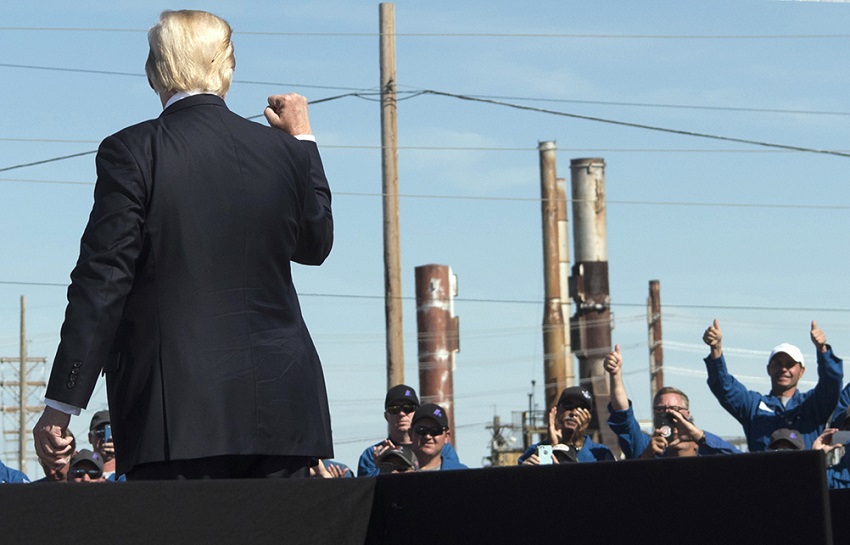Trump Signs Orders to Ease Pipeline Approval, Construction
CROSBY, Texas (P&GJ) – President Donald Trump on Wednesday signed a pair of executive orders intended to ease permitting and construction of pipelines and other energy infrastructure – an action that quickly drew the praise of industry organizations.
One of the orders directs Environmental Protection Agency (EPA) Administrator Andrew Wheeler to review the agency's permitting process to speed up the construction of natural gas pipelines. It specifically directs EPA staff to review regulatory language that gives authority to states under the federal Clean Water Act (CWA), which has been used by New York regulators to block the construction of pipelines to transport natural gas from the nearby Marcellus and Utica basins.
Another order, intended to streamline approval of cross-border pipelines, clarifies that the President will make the decision on whether to issue permits for such projects. Currently, the Secretary of State has the authority to issue permits for such cross-border projects as the proposed Keystone XL pipeline, which would extend from Hardisty, Alberta, to Steele City, Nebraska.
Trump timed the executive orders Wednesday with a fund-raising trip to Texas, where he spoke at the International Union of Operating Engineers International Training and Education Center in Crosby, northeast of Houston. The orders are part of a broader initiative to achieve a goal that the Trump Administration refers to as global “energy dominance.”
After arriving in Crosby, he told a crowd of about 300 people that the "era of job-killing regulations is over." [Read full text of President Trump's remarks in Crosby]
The Interstate Natural Gas Association of America (INGAA) and the American Gas Association (AGA) were among organizations that responded with praise for the actions on behalf of the industry.
“Currently, the process for reviewing and approving new or expanded interstate natural gas pipelines is robust and transparent – two things that we continue to believe are essential – but procedural inefficiencies can delay a process that already spans several years,” said Don Santa, president and CEO of INGAA, in a statement. “Streamlining the process to ensure it is safe, comprehensive and predictable is a top priority, along with EPA clarifying Clean Water Act section 401 water quality certification requirements so that one state cannot interfere with interstate commerce.
“We look forward to learning more about the administration’s plans to expedite the permitting and review process for the critical infrastructure that allows Americans to continue enjoying the many benefits of natural gas,” Santa said.
AGA President and CEO Karen Harbert said Trump’s executive orders “clear the way for development of new natural gas pipelines, enabling greater access to natural gas thereby benefitting American families and our environment.”
America’s natural gas utilities add an average of one new customer every minute nationwide servicing the millions of Americans who want access to gas, the AGA noted in Harbert’s statement Wednesday. The association, which represents many of the nation’s local distribution companies (LDC), also cited a recent study from the National Bureau of Economic Research found that the drop in natural gas prices averted 11,000 winter deaths per year in the U.S.
“When states say ‘no’ to the development of natural gas pipelines, they force utilities to curb safe and affordable service and refuse access to new customers including new businesses. Limiting access and choice for Americans - driving up costs and emissions in the process - is simply bad policy,” Harbert said.
INGAA’s Santa added, ““We are pleased that the administration is building upon earlier actions to streamline the permitting and review process for critical energy infrastructure projects. Ensuring that our abundant domestic supply of natural gas can safely reach end users is critical if we are to fully realize the benefits of this clean-burning, job-creating resource and natural gas infrastructure is the foundation of that vision.
According to AGA, increased use of natural gas has led to U.S. energy-related carbon dioxide emissions hitting 25-year lows. The association said public policy at every level should recognize the role that the direct use of natural gas will continue to play in reducing greenhouse gas emissions.
“Americans deserve a choice when it comes to their energy and enabling the development of natural gas pipelines gives them an opportunity to choose reliability, affordability and a clean energy future,” Harbert said.
In addition to the EPA directives, Trump also instructed the departments of Transportation, Agriculture, Commerce and Interior to review ways to ease LNG transport by rail and LNG’s ability to build electric power lines across private land.
A group of business organizations submitted a letter to EPA Administer Wheeler last week alleging that states have been using the CWA’s environmental review and permitting process for energy projects as an activist tool to oppose production and use of fossil fuels. The Trump administration, however, has emphasized that its goal is to ensure states follow the intent of the CWA and not to take power away from them.
Trump issued a new presidential permit for the Keystone XL last month, two years after he first approved it and more than a decade after it was first proposed.
Related News
Related News

- Kinder Morgan Proposes 290-Mile Gas Pipeline Expansion Spanning Three States
- Enbridge Plans 86-Mile Pipeline Expansion, Bringing 850 Workers to Northern B.C.
- Intensity, Rainbow Energy to Build 344-Mile Gas Pipeline Across North Dakota
- Tallgrass to Build New Permian-to-Rockies Pipeline, Targets 2028 Startup with 2.4 Bcf Capacity
- U.S. Moves to Block Enterprise Products’ Exports to China Over Security Risk
- U.S. Pipeline Expansion to Add 99 Bcf/d, Mostly for LNG Export, Report Finds
- A Systematic Approach To Ensuring Pipeline Integrity
- 275-Mile Texas-to-Oklahoma Gas Pipeline Enters Open Season
- US Poised to Become Net Exporter of Crude Oil in 2023
- EIG’s MidOcean Energy Acquires 20% Stake in Peru LNG, Including 254-Mile Pipeline





Comments